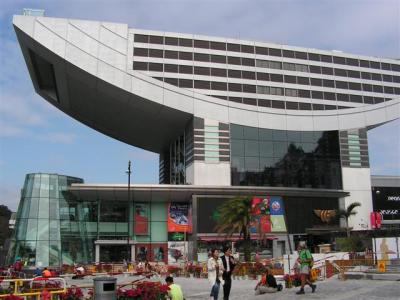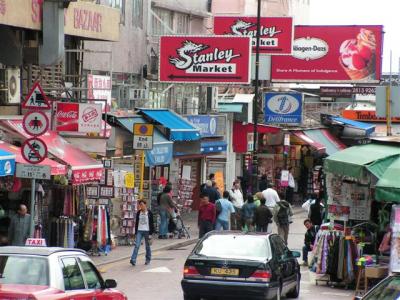This morning Eric and Christi went on a guided tour at the History Museum. Omar and Marion wanted to sleep in since they were out late shopping. Hong Kong has more than a dozen museums that are all supposed to be really good. A museum buff can easily be entertained for a week or more in Hong Kong.
The museum is in the Tsim Sha Tsui part of Kowloon, only a few kilometers away from our hotel. It is across the street from a University and next door to the Science Museum. There is a quaint old colonial church across the way, but we didn’t have time to go in and check it out. We had barely made it to the museum in time for the tour.
The museum is really amazing. They went over the top in making the museum interactive and comprehensive. There are no plain walls with small, glass encased exhibits. Each exhibit is actually a complete recreation of that moment in history. For example, the tour starts in a room constructed to look like you are underground. The exhibits explain the composure and geological structure of the soil. The next room is a recreation of what Hong Kong looked like prior to development, complete with trees, stuffed animals, wax people dressed in traditional attire for the area, etc. You get the idea. Our guide was completely fluent in English, which is no surprise, as most people here are bilingual in Chinese and English. He was personable, funny, and definitely helped bring the history to life.
Needless to say, most of the history revolves around China and the various leaders and dynasties, which is quite interesting. There was a really neat display of some of the unique Chinese cultures and traditions that was quite fascinating. Once the British took over, the history became very similar to Singapore’s. Both islands were sparsely populated fishing villages before being transformed into prosperous trading ports. Both cities were plagued with the same issues of overcrowding, poor sanitation and opium addiction. The room that recreated the 20’s had two story row houses that looked much the same as the turn of the century buildings in Singapore. The shops were supposedly typical of an average street, and included an opium parlor.
During WWII, the Japanese captured most of coastal China, including Hong Kong. The Japanese were ruthless to the Chinese and the Japanese caused a lot of destruction throughout all the war torn areas, including Hong Kong. After WWII, refugees poured into Hong Kong from mainland China. They lived in shanty towns. There was a big fire that burned down the shanty towns, so the government began to build housing. At first the housing was pretty bad, one minuscule small room per family with a communal bathroom for 400 people, but over the years the developments have improved.
In the fifties and sixties Hong Kong became the manufacturing hub of the world. There was a room with exhibits displaying the various products manufactured there, including watches and cameras and toys. Christi got excited when she saw a Bob’s Big Boy piggy bank, which was a beloved toy of hers as a child. As manufacturing moved to Taiwan, Hong Kong developed as an international banking center. At the end of the tour, the guide talked about the hand off of control from Britain to China, and the effects felt so far, which seem to be pretty minimal overall.
The tour was longer than expected and we were late to meet Omar and Marion, so we rushed out of the museum once the tour was done. We could have easily spent several more hours there, going through the exhibits more carefully and watching the various media clips throughout the exhibits. The four of us headed back over to Hong Kong Island, where we walked to the Victoria Peak Tram Station. From what we have seen of Singapore, it is pretty darn flat, with only a few relatively small hills on the islands. Hong Kong is mountainous. Eric and Christi took the tram up the mountain to check out the views from up high. Marion and Omar have already been, so we agreed to meet up later.
The tram ride up was incredibly steep. You land at a building on top of one of the higher but not the highest — peak. You can walk outside and enjoy the views, take a walk, or go shopping at a mall behind the station. Or, for an extra fee, you can take an escalator up several more flights of stairs to the roof of the station. Each level has lots of shops on it.

The view is really beautiful from the top. It is a 360 degree panorama, so on one side you can see downtown and Kowloon, and on the other side the south side of Hong Kong Island, as well as several nearby islands.
We took the tram back down to the station at the bottom, where Omar and Marion were waiting for us. We headed down to a colonial era church a block down the street. It is quaint and charming inside.
Marion needed to go to the airport to claim her bag, so after a short visit, she headed out. Omar, Christi and Eric boarded a bus to the south side of the island. The bus passed through Times Square and shortly after climbed up a very narrow mountain road. As we started to ascend the mountains, the buildings transitioned into small, well spaced residential buildings, which was a nice change from the tightly packed high rises down below. The farther away from the city we got, the more expensive looking the buildings appeared. We even started to see some houses. As we neared the southern side of the island, the road began to parallel a large bay. The bay looks well protected and there seemed to be quite a few private boats anchored. This appears to be a really ritzy part of town. There are lots of tall, very fancy high rises set back from the water that overlook the bay, and along the bay it looks like an upscale private community of houses.
We got off the bus at Stanley Market, kind of in the middle of the south side of the island at the southwest mouth of the bay entrance. It is yet another shopping area of little mom and pop stores. Like the Temple Street night market, we were surprised by the variety of products they had to offer, and how useful some of the products are. We even lucked out and found a store that sells camping clothes, something we have been desperately looking for in Singapore. Camping clothes work great for boating life, but sadly, they don’t seem to wear all that well. We both got a couple pairs of quick dry pants.

At the edge of the market area are some old original Chinese style homes for that area that are still standing. They are low, one story row houses and look like they are quite small inside. They overlook the water, which offers beautiful views of the bay and the buildings on the other side of the bay.

It was dark now and we needed to get moving in order to catch our plane back to Singapore. We hopped on the bus, which dropped us off a couple blocks from the ferry terminal. We took the ferry back to Kowloon, which is an even prettier ride at night with all the buildings lit up on both sides of the bay.
Every night at 2000 (8:00 pm), there is a light show and it was just starting as we exited the ferry. The quay was jam packed with people who turned out for the show. We watched for a couple of minutes, but we really needed to get going. We headed back to the Holiday Inn, where we had left the bags at the front desk, grabbed our bags and hopped the shuttle to the airport.
At the airport, Marion was waiting for us at the counter with a long face. Her bag had not arrived. The person she had talked to earlier today had lied when they said that the bag had definitely made it on today’s flight. On the way back, Eric and Christi got stuck in coach, while Omar and Marion got to sit in business class. Being back in coach was a good reminder about why we chose to travel via boat as opposed to plane. Another good reminder is Marion’s missing luggage.
By the time we landed and took a taxi across Singapore to the boat, it was 0500. We had been gone slightly more than 48 hours.

You are so right it is beautiful at night…great photos..I would have loved the hike for sure! 🙂